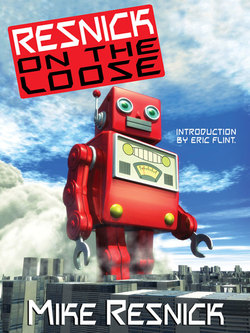Читать книгу Resnick on the Loose - Mike Resnick - Страница 15
На сайте Литреса книга снята с продажи.
ОглавлениеThe Greatest Thinker of Them All
Science fiction isn’t like any other field. Here we consider it an honor when someone builds on our ideas. Alfred Bester could write The Demolished Man, and then Robert Silverberg could write his answer to it in The Second Trip, and I could write my answer to Silverberg in “Me and My Shadow,” and somebody could fictionally answer me, and nobody cries foul.
It happens all the time. But there is one particular writer whose ideas have been built upon by almost every science fiction writer for three-quarters of a century—and the wild part is that not only don’t most fans know his name, but most pros who have used his notions as a springboard for their own stories and novels haven’t even read him. His idea have been so thoroughly poached and borrowed and extrapolated from and built upon that writers are now borrowing five and six times removed from the source.
So I think perhaps it’s time to tell you a little something about that source, because he science fiction’s most remarkable thinker. His name was Olaf Stapledon.
Stapledon was a college professor, a Doctor of Philosophy at the University of Liverpool, and except for reading H. G. Wells, he probably had no idea that the field of science fiction existed. He certainly hadn’t seen the pulp magazines, and he didn’t know Hugo Gernsback’s name for it (and in fact, when he began, Gernsback was still using the original “scientifiction” rather than breaking it into two words.)
Stapledon wasn’t an elegant writer. I freely admit that his prose tends to crawl rather than soar—but his ideas soared higher than anyone else’s ever had.
His first novel was Last and First Men, which follows the human race through eighteen startling evolutions for more than two million years, until our eventual extinction. In one evolution, we’re nothing but giant brains. Later we emigrate to Venus, and eventually to Neptune, changing our bodies each time to adapt to our new environments.
Not bad for 1930. It is truly a novel of titanic concepts and sweeping vision—and it is condensed into very little more a page in his masterpiece, Star Maker, which is nothing less than the history of this and every other universe ever to exist from the beginning to the end of Time. Brian Aldiss has argued that this is the most important science fiction book ever written; I have shared that opinion from the day I finished the book more than 40 years ago.
It was in Star Maker that Stapledon explored the notion of galactic empires. He created endless races, some humanoid, some ichthyoid, some arachnoid, each with its own outlooks and morals and goals. People—well, intelligent beings, anyway—travel between the stars and ultimately even among the galaxies.
But there’s more. The stars themselves are sentient, and eventually all the sentient entities in the galaxy—men, aliens, stars, everything—merge into a single Cosmic Mind.
But Stapledon didn’t even stop there. He was interested in what created that Cosmic Mind, and became the first—and almost the only—to tackle the notion of God (i.e., the Star Maker) in a non-religious way.
It’s almost impossible to find a science fiction idea in the pulps of the 1930s and 1940s, or even the digests of the last half century, that does not owe something—usually a major something—to Stapledon. (In fact, when Larry Niven’s brilliant Ringworld came out and credited Dyson Spheres as its inspiration, I decided that that was the first truly major science fictional concept that did not owe anything to Stapledon. I should have known better. When I read Freman Dyson’s autobiography a few years later, I discovered—not surprisingly, in retrospect—that he credited Stapledon with inspiring the notion of the Dyson Sphere.)
Those two novels were quite enough to solidify Stapledon’s place in the history of science fiction, but he wrote two others, not as huge in scope or as bold in concept, but sufficiently influential that any writer other than Stapledon would be happy to let his reputation rest on them. One was Odd John, the first novel of a mental (rather than a physical) superman; and the other was Sirius, about a dog with artificially enhanced intelligence. (I wonder how many books and stories owe a tip of the hat to those two “minor” novels? 500? 1,000? More?)
And now, three-quarters of a century after his two major works appeared, the books are all but forgotten. Ask almost any American science fiction writer if he’s heard of Stapledon and he’s likely to answer in the affirmative. Ask him if he’s read Star Maker and the answer will usually be No.
And yet Stapledon’s ideas are alive and well. You’ll find them in almost every story in almost every issue of Analog and Asimov’s and Jim Baen’s Universe, and in well over half the science fiction novels you’ll find in the bookstores and the libraries.
You might even mosey over to your local library or second-hand bookstore, pick up a copy of Star Maker (and perhaps Last and First Men as well) and experience our greatest thinker first-hand. Some of the concepts in them will seem like old friends, but others are still capable of blowing you away—which is one of the things that the very best science fiction is supposed to do.
